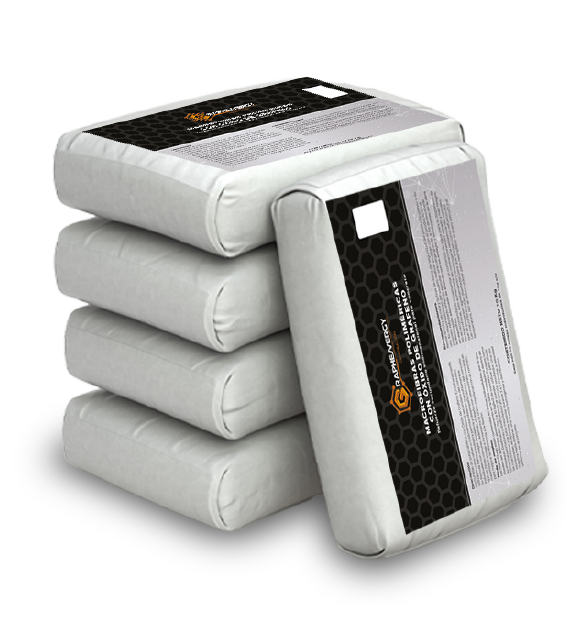

IMPROVE THE DURABILITY OF CONCRETE WITH MACROFIBERS FROM GRAPHENEMEX
Increase flexural strength, improve concrete toughness, and reduce cracking, all while extending the lifespan of your structures.
CONTACT US AND LET OUR EXPERTS HELP YOU
GUIDE
Our macrofibers provide high-performance three-dimensional reinforcement for concrete.
Increase Flexural strength
Increase mechanical strength
Reduces cracking
High resistance to chemical attacks and cialis
Decreases segregation
Greater impermeability
USES – Reinforcement of industrial slabs with light, medium, or heavy traffic
– Parking areas
– Concrete pavements with varied traffic
– Applications in channels and dams
– Cast elements with sliding formwork
– Wet or dry shotcrete, both permanent and temporary
– Prefabricated elements

PRESENTATION– Water- soluble paper bags with 2.2 kg of product
– Box with 7 bags of 2.2 kg each
INSTRUCTIONS Macrofibers can be incorporated before, during, or after concrete dosing.
It is recommended to use equipment such as conveyor belts and dosers to add them to the mix.
Next, mix for 3 to 5 minutes at maximum speed to ensure even distribution.
It is important to add them slowly to avoid accumulations. In some situations, water reducers may facilitate uniform distribution.
DOSAGE 300 g of macrofiber per one bag of cement.
A 2.2 kg water-soluble bag has a yield for one cubic meter of concrete. Equipment such as conveyor belts and dosing systems can be used to add the macrofibers to the mixing hopper and/or mixer truck.
Once incorporated, it is important to mix during 3 to 5 minutes at maximum speed, to get an homogeneous mixture and uniform distribution in concrete.
IMPORTANT INFORMATION Do not increase water content to disperse macrofibers, as this can cause drying shrinkage and reduce concrete strength.
These macrofibers are designed to act as reinforcement for temperature and should not be used as a substitute for structural steel.

LEARN MORE ABOUT THE GREAT BENEFITS THAT MACROFIBERS OFFER TO YOUR PROJECTS
View resourcesFREQUENTLY ASKED QUESTIONS
View questions- What material are Graphenergy macrofibers made of? Macrofibers are produced from plastic polymeric compounds, specifically Polypropylene reinforced with graphene oxide through the extrusion process.
- At what stage are macrofibers added to the concrete? Macrofibers are added during the concrete mixing process, either in a mixer or in the mixing truck.
- How many macrofibers are dosed per m3? The recommended dosage is typically in the range of 2 to 10 kg/m3. However, it is important to consult with the site supervisor to determine the ideal dosage according to the project.
- Is it necessary to remove them from the packaging before adding them? Macrofibers are contained in water-soluble bags. When the product comes into contact with water, the bags will immediately disintegrate, allowing the fibers to mix into the concrete. Therefore, it is not necessary to extract them from the bag for dosing.
- Are special conditions required for storing macrofibers? The product should be stored in a dry place at room temperature, away from strong oxidizers and ignition sources. Because the bags are water-soluble, meaning they degrade upon contact with water or in humid environments, it is important to store them in dry conditions.
- Are macrofibers with graphene oxide toxic? No, macrofibers with graphene oxide are not toxic. They are handled like any other concrete fiber, and the use of personal protective equipment is recommended, especially when using shotcrete.
- What is the main difference between commercial polymeric macrofibers and Graphenergy macrofibers? The main difference between Graphenergy reinforcement fibers and other commercial fibers is that graphene fibers become part of the concrete matrix, resulting in a composite material. Graphenergy reinforcement fibers form a reinforcement network throughout the structure, reducing or inhibiting crack formation (effective crack control) and improving the ductility of the concrete.
- How does graphene oxide improve the performance of macrofibers?
Distribution within the concrete mix
The surface chemistry of graphene oxide helps maintain the affinity of the fibers with the aqueous elements of the cement paste. This is because graphene oxide reduces the surface energy of the fibers, facilitating their distribution within the mix and preventing aggregation.
Adhesion
Graphene oxide assists in the electrostatic repulsion between cement particles, preventing their agglomeration and increasing the degree of fiber-cement interaction. In hardened concrete, this effect increases the friction coefficient, requiring more load to displace a fiber within the concrete.
Mechanical strength
Graphene oxide enhances the tensile and rupture strength of polymers. Therefore, fibers with graphene oxide have a lower risk of fracture and are more durable than common fibers.
Resistance to degradation
Polymeric fibers with graphene oxide have a longer lifespan because graphene oxide maintains its structural integrity and mechanical properties. Additionally, it is chemically inert and more resistant to corrosive environments compared to many other materials that degrade due to UV radiation.
Thermal stability
Graphene oxide improves the thermal stability of polypropylene by forming interconnected bridges throughout the polymer matrix, enhancing heat transport. - What are the main benefits of Graphenergy macrofibers? Graphenergy macrofibers enhance tensile strength by over 38% compared to commercial macrofibers, as they absorb stresses at any point and direction. They improve fatigue and impact resistance in concrete and also increase the durability of structures by reducing cracking. Additionally, the presence of macrofibers decreases moisture permeability in concrete, limiting water transmission.
- Do Graphenergy macrofibers have an expiration date? Since macrofibers are made from thermoplastic polymers, they do not have an expiration date. However, it is recommended to store them in a protected place, free from moisture or exposure to extreme weather conditions.
- What is the chemical resistance of macrofibers? The incorporation of graphene oxide provides high chemical resistance to macrofibers against acids, alkalis, and salts. It also offers excellent resistance to UV radiation.
We want to be close to you
We ask for your data to support you in any technical questions you may have.











